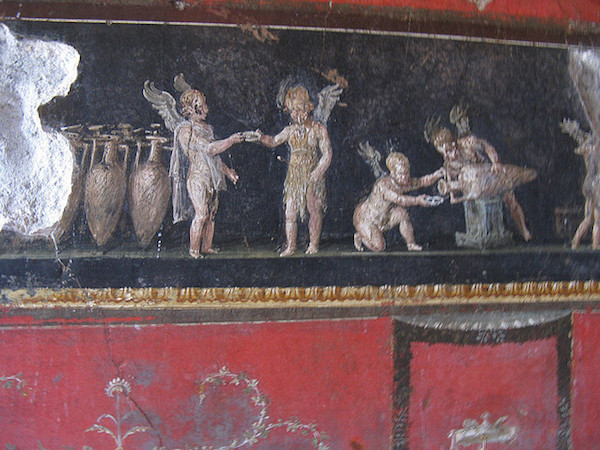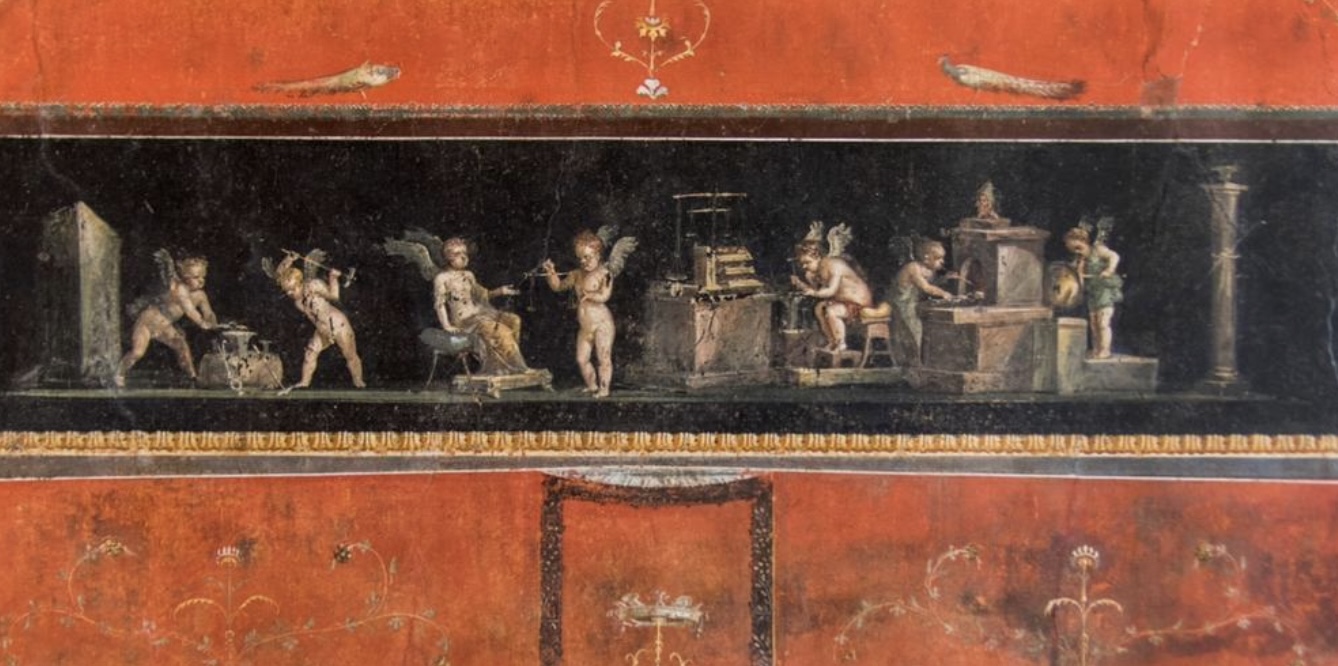Table Of Content

The stone-lined basin for collecting rainwater (impluvium) lies at the center of the atrium. This larger atrium communicates directly with the peristyle (an open courtyard surrounded by fluted Doric columns) by means of a set of folding doors. The smaller atrium was the focus of the service portion of the house, while the peristyle and its well-appointed rooms was meant for entertainment and dining. The final mythological scene in the south-east triclinium is Cyparissus on the north wall.
The Real Story Behind George Washington's Dentures
The office of the head of household (paterfamilias), known as the tablinum, links the public part of the house (pars urbana) to the private part of the house (pars rustica). This latter area often focuses on an open, colonnaded courtyard (peristylium) and serves as the center of family life, with the kitchen (culina), dining room(s) (triclinium or oecus), and often a small garden (hortus). Many houses also had a second level that may have contained additional sleeping spaces and perhaps storage. A house is, of course, a dwelling—but it is also a stage on which the rituals of daily life and social hierarchy would be performed.
View within Art Histories
Domestic spaces, in particular, offer a rich resource for examining ancient lives that, in some cases, ended abruptly. Pompeii was thriving up until the moment of its destruction and in studying its life interrupted, we arrive at important insights about what it was like to live in the Roman Mediterranean. The final mythological scene in the south-east triclinium is Achilles on Skyros, painted on the east wall. After learning that Achilles would die during the Trojan War, his mother, Thetis, sent him to live on the island of Skyros. Odysseus displays gifts in front of the King's daughter, including arms and armor. The final mythological scene in the southern triclinium is the Infant Herakles strangling the snakes, located on the north wall.
Noteworthy Details
The house itself is architecturally significant not only because of its size but also because of the indications it gives of important changes that were underway in the design of Roman houses during the third quarter of the first century C.E. A section of the 1st century CE cupids frieze from the triclinium or dining room from the House of the Vetti in Pompeii. The frieze depicts cupids selling flowers and perfumes and as workers who sell flowers, make wine and work gold. Leaving the living room and following the Peristyle we find a few rooms set to one side and thought to have been reserved for women (gynaeceum) , where we can see a Triclinium and a Cubiculum opposite a small garden. Two frescoes in this area depict Odysseus recognising Achilles, and Auge surprised by a drunken Hercules. The decision to site them here can probably be explained by the desire of the masters of the house to underline their wealth and importance.
Institutional Portal of the Archaeological Park of Pompeii
Richly decorated with impeccably preserved frescoes — including the Cupid Rooms, which reveal a 15cm-high frieze of cupids preparing for a banquet — the house is considered one of the most outstanding examples of first-century Roman art. "We're seeing here the last phase of the Pompeian wall painting with incredible details, so you can stand before these images for hours and still discover new details. The newly restored remains of an opulent house in Pompeii has offered visitors an exceptional peek at details of domestic life in the doomed Roman city.
In Maine, the Art of Basketry Hangs On By a Thread
"The House of the Vettii is like the history of Pompeii and actually of Roman society within one house," Pompeii's director, Gabriel Zuchtriegel, said as he showed off an area known as the Cupid Rooms. The House of the Vettii, a significant point of interest within the Pompeii Archaeological Park, is conveniently located in the Regio VI district. As you enter the park from the main Porta Marina entrance, head east on Via dell’Abbondanza, one of the main streets of ancient Pompeii. The House of the Vettii in Pompeii, named after its presumed owners, the Vettii brothers, served as a residential building with a distinct societal role. This grandiose domicile was a symbol of wealth and status, intended to display the prosperity of the Vettii, successful freedmen who ascended the social ladder through commerce.
The plan of the house
The only surviving mythological scene in the triclinium next to the small peristyle is Herakles and Auge, painted on south wall. This scene depicts the myth of the rape of Auge, who was the daughter of the King of Taega and the priestess of Athena, by a drunken Herakles. The second mythological scene in the southern triclinium is the Punishment of Dirce, which is located on the south wall.
Plan
It offers visitors a glimpse of Ancient Roman life in the corner of Italy frozen in time after Mount Vesuvius's eruption in 79 AD. In the living room, known as the Hall of Pentheus, a fresco depicts Hercules as a child, crushing two snakes, in an illustration of an episode from the Greek hero's life. Mr Zuchtriegel said fresh "readings" of the revived fresco painting reveal the "dreams and imagination and anxieties of the owners because they lived between these images'', which include Greek mythological figures. The house was constructed using a variety of materials, including opus craticium (a framework of timber filled in with rubble), opus incertum (small stones set in concrete), and opus reticulatum (a diamond pattern of small, pyramidal stones).
For Sale: A Mouse-Infested Roman Helmet That's Stumping Historians
House of the Vettii: Pompeii home owned by former slaves reopens - BBC.com
House of the Vettii: Pompeii home owned by former slaves reopens.
Posted: Tue, 10 Jan 2023 08:00:00 GMT [source]
After being welcomed into Olympus by the god, Ixion grew to lust after Zeus's wife, Hera. After Ixion attempts to seduce her, Zeus creates the cloud goddess Nephele in the image of Hera. As punishment, Zeus banishes Ixion from Olympus and orders Hermes to tie Ixion to a winged fiery wheel, which is to spin for eternity. Beyond the twelve mythological paintings, many more artworks are displayed in the House of the Vettii. The next room is decorated with frescoes depicting the struggle between Cupid and Pan, Cyparissus who is transformed into a cypress tree after killing a sacred stag and, lastly, some images of Jupiter in the upper section of the wall. The two rooms (alae) opening off the Atrium just before it leads into the garden have frescoes painted on a yellow background; these depict a cock fight on the left, and two medallions portraying the heads of Medusa and Silenus on the right.
There are various traces of the life of the poor, in particular a room adjoining the kitchen in the slaves’ quarters which is decorated with small erotic paintings. The room was originally fitted with an iron door to ensure that access was restricted only to adult men. It has been suggested that the room was used for prostitution, a hypothesis that appears to be confirmed by the discovery of an inscription on the left wall of the vestibulum (entrance hall). The inscription refers to a woman named Eutychis, “a Greek woman of pleasant manners”, who was offered for two asses (copper coins) (Eutychis Graeca a(ssibus) II moribus bellis). Besides the beauty of ancient art and architecture, this find offers an extraordinary insight into ancient society, its stratification and customs.

The patron-client system revolved around asymmetrical social relationships whereby lower ranking clients were bound to their patrons by the qualities of trust (fides) and dutifulness (pietas). Governed by ancestral custom (mos maiorum), clients would seek support and favors from the patron; in turn the patron provided protection, support, and benefaction, collectively known as patrocinium. This system had changed somewhat by the time of the brothers Vettii and it is unclear to what extent the patron-client system factored in their lives or in their own domestic sphere.
Continue until you reach the junction with Vicolo Meridionale, turn right, and you will find the House of the Vettii on your left. This strategic location within the archaeological site ensures easy accessibility for all visitors keen to glimpse into Pompeii’s illustrious past. In recent years, however, they have also started broadening their focus, excavating sites such as a middle-class home and an enslaved family’s living quarters. In the cubiculum next to the large atrium, Ariadne abandoned by Theseus is painted on the north wall.
The garden also has ancient species of plants cultivated in the nursery within the Park as a part of a more wide-ranging project designed to enhance historic gardens and the cultivation of green areas of the ancient city through partnerships with local farmers and plant growers. The newly restored remains of an opulent house in Pompeii that likely belonged to two former slaves who became rich through the wine trade offer visitors an exceptional peek at details of domestic life in the doomed Roman city. One of its most famous frescoes is right by the doorway to the house and depicts Priapus, the Greek god of fertility, weighing his gigantic penis on a set of scales leaning against a bag of money. An image that was likely supposed to symbolize the owners' wealth and perhaps to impress (or intimidate) the neighbors. Generally entered from the street via a narrow doorway (fauces), the large centralized reception hall (atrium) is flanked by wings (alae) and often bounded by bedrooms (cubicula).
The Guardian reports that the House of the Vettii was located in one of Pompeii’s wealthy neighborhoods. The property included statues, gardens, fountains, vibrant — and sometimes erotic — frescoes, and even a brothel. Although the house partially opened in 2016, it closed again in 2020 to allow for complete restoration work before finally reopening on January 9.
The specific Romans who inhabited the House of the Vettii were Aulus Vettius Restitutus and Aulus Vettius Conviva, wine merchants who made their fortunes after being freed from slavery. The strongboxes, paired with a painting of the god Priapus in the vestibule, serve to underscore the wealth of the brothers Vettii. This painting, which shows Priapus weighing his own phallus against a bag of money, may represent the socio-economic ambitions of the Vettii and perhaps indicates that those ambitions were different from those of high-ranking citizen families.
No comments:
Post a Comment